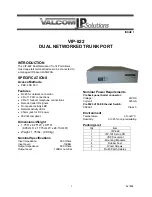
DES-3010F/DES-3010FL/DES-3010G/DES-3016/DES-3018/DES-3026 Fast Ethernet Switch Manual
109
Section 8
CoS
Port Bandwidth
802.1p Default Priority
802.1p User Priority
CoS Scheduling Mechanism
CoS Output Scheduling
Priority Settings
TOS Priority Settings
DSCP Priority Settings
Port Mapping Priority Settings
MAC Priority
CoS
The Switch supports 802.1p and other priority protocols. The following section discusses the
implementation 802.1p priority queuing and the Class of Service or CoS mapping on the Switch.
IEEE 802.1p Priority
Priority tagging is a function defined by the IEEE 802.1p standard designed to provide a means of managing
traffic on a network where many different types of data may be transmitted simultaneously. It is intended to
alleviate problems associated with the delivery of time critical data over congested networks. The quality of
applications that are dependent on such time critical data, such as video conferencing, can be severely and
adversely affected by even very small delays in transmission.
Network devices that are in compliance with the IEEE 802.1p standard have the ability to recognize the
priority level of data packets. These devices can also assign a priority label or tag to packets. Compliant
devices can also strip priority tags from packets. This priority tag determines the packet's degree of
expeditiousness and determines the queue to which it will be assigned.
Priority tags are given values from 0 to 7 with 0 being assigned to the lowest priority data and 7 assigned to
the highest. The highest priority tag 7 is generally only used for data associated with video or audio
applications, which are sensitive to even slight delays, or for data from specified end users whose data
transmissions warrant special consideration.
The Switch allows you to further tailor how priority tagged data packets are handled on your network. Using
queues to manage priority tagged data allows you to specify its relative priority to suit the needs of your
network. There may be circumstances where it would be advantageous to group two or more differently
tagged packets into the same queue. Generally, however, it is recommended that the highest priority queue,
Queue 3, be reserved for data packets with a priority value of 7. Packets that have not been given any
priority value are placed in Queue 0 and thus given the lowest priority for delivery.
A weighted round robin system is employed on the Switch to determine the rate at which the queues are
emptied of packets. The ratio used for clearing the queues is 4:1. This means that the highest priority queue,
Queue 3, will clear 4 packets for every 1 packet cleared from Queue 0.
Remember, the priority queue settings on the Switch are for all ports, and all devices connected to the
Switch will be affected. This priority queuing system will be especially beneficial if your network employs
switches with the capability of assigning priority tags.
Summary of Contents for DES-3010F
Page 260: ...247 ...















































